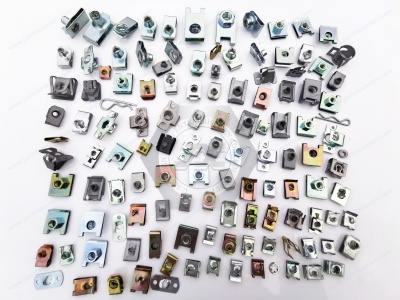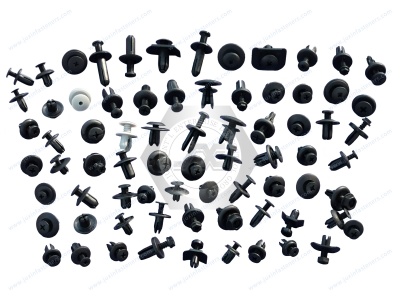Call Us
+86 136 6007 9809
Call Us
+86 136 6007 9809
Jan. 22, 2024
The number of fasteners applied to an ordinary automobile can reach more than 3,000, and most non-standard fasteners are used in the interior and exterior of cars. Due to the complex structure of the interior and exterior parts, various materials, and different molding methods, resulting in a wide range of installation methods, the application of a wide range of fasteners, the establishment of an internal and external typical fasteners library can effectively save the design time of structurally similar parts in the process of product development, to adapt to the market's requirements for the rapid transformation of automotive products.
Types of fasteners
1. C-type buckle: The C-type buckle is widely used for door trim plates, A B column trim plates, carpet layering, and other internal and external decorative plastic parts and body sheet metal connections, mainly as a fastener.
The C-type buckle material is usually polypropylene plastic (PP), polyethylene plastic (PE), amide plastic, or similar materials, and the commonly used material is PA6 or PA66.
Although there are more types of existing C-type buckles, most are similar in structure. Usually, the buckle is installed on the buckle seat of the internal and external trim, and then the buckle is stuck on the sheet metal part through its elasticity to achieve the role of tightening.
2. B-type buckle: A B-type buckle is usually used to fix foam parts, blister parts, and felt parts with low appearance requirements, such as connecting carpet or top interior and exterior decoration with body sheet metal.
The type B buckle material is usually PP, PE, or similar plastic, and the commonly used material is nylon (PA6 or PA66).
B-type buckle structure is relatively simple and does not need to be in the internal and external decorative parts for matching features; installation through the buckle's elastic stuck on the matching parts plays a tightening role. Figure 2 below shows the standard type B buckle and matching structure.
3. Plastic cotter pin: Plastic cotter pins are mainly used for connecting carpet and body sheet metal, top and interior decoration, and body sheet metal. They play a fastening role. They can also be used to fix plastic parts with low appearance requirements.
The materials are usually tensile, corrosion-resistant, and water-resistant polyacetal resin or polyamide. At present, the commonly used material is POM or PA66.
The plastic tail pin includes a plastic tail pin seat and a plastic pin. When installing the plastic tail pin seat, the plastic tail pin is first installed, and then the plastic pin is inserted into the pin seat to expand the pin seat and play a fastening role.
4. Plastic insert nuts: Plastic insert nuts are usually installed on sheet metal parts and are matched with self-tapping screws to connect and tighten plastic parts and sheet metal parts.
The material of plastic-embedded nuts is generally PA6 or PA66, and other plastics have better mechanical properties.
Plastic embedded nuts include end seal and through-hole types, with specific selection specifications depending on the situation. During installation, the plastic nut is first installed on the sheet metal, and then the internal and external trim is matched with the plastic nut through screws to tighten the function. Figure 4 below shows the end-sealed plastic insert nut and matching structure.
5. Elastic clip: The elastic clip is mainly used in the instrument panel system, such as the connection of the center control panel or other cover parts and the instrument panel body to play a fastening role. Elastic clips are often used for parts that require high appearance quality and do not bear loads.
Elastic clips are available in metal and plastic. The adjustable clip material of plastic is usually PA6 or PA66, and other plastics with better mechanical properties. The material of metal elastic clips is usually 65, and other metal materials have good toughness and elasticity.
Although the elastic clip material is different, the structure is similar. Usually, the buckle is installed on the flexible clip seat of the internal and external trim, and then the elastic clip is stuck on the matching piece to achieve the role of tightening.
6. Reed nut: The reed nut is usually installed on the plastic parts or sheet metal parts and is matched with the tapping screw to connect and tighten. It is commonly used to connect the instrument panel parts and the instrument panel body or the instrument panel body and beam. The reed nut is usually metal with good toughness and elasticity, such as 65Mn. There are two kinds of standard reed nuts, respectively, with and without the anti-stripping structure. The reed nuts with the anti-stripping structure are usually used to connect plastic and metal parts. When installing, the reed nut is first installed on the plastic or metal parts, and then the internal and external decorative parts are matched with the reed screw through the self-tapping screw to play a tightening role.
The establishment of a fastener library
Taking the standard matching mode between plastic parts of the instrument panel system and the reed nut matching ST4.2 self-tapping screw as an example, the method of building a typical fastener library with CATIA is introduced.
1. Parametric modeling: Create the digital model of the reed nut and its matching self-tapping screw and flat washer assembly in CATIA, and also create two plastic parts matching structures with the reed nut and self-tapping screw.
2. Create parameters and formulas: In the process of modeling, it is necessary to determine the critical dimension parameters of the reed nut and the plastic parts matched with it according to the specifications of the self-tapping screw.
3. Create the Design Table: After completing the mathematical model, you can create the design table grid through the design table command in the Knowledge toolbar. The purpose of making the design table is to drive the parameters developed in the table through the corresponding parameter values of the design table so that the reed nut can be matched with different specifications of self-tapping screws. After making the design table, establish the corresponding reed nuts and corresponding plastic parts parameters according to varying specifications of self-tapping screws.
4. Create a typical fastener library: After creating the design form, create a Catalog Document to establish a typical fastener library for interior and exterior decoration.


The application solution of the fastener library
Taking the combination of air outlet and instrument panel as an example, the application method of a typical fastener library is introduced.
1. Establish the assembly file: First, create and guide the digital model of the instrument panel body and the central outlet into it.
2. Import the fastener library into the assembly: Under the assembly module, select the Catalog Brower command, select the interior and exterior fastener library of the Catalog file created earlier, and then select the A-reed nut NS4201 to import into the assembly file.
3. Constrain the reed nut: Use the coaxial and surface restraint commands in the restraint toolbar to correctly constrain the mating relationship between the reed nut fastener and the air outlet.
Standard interior and exterior decoration fasteners, and taking reed nuts and self-tapping screws as an example, the establishment method of interior and exterior decoration fastener library. Method of using fastener library. Building the interior and exterior fasteners into CATALOG library files can not only improve the design efficiency of interior and exterior trim parts but also shorten the design cycle, reduce the design cost, and significantly improve the effectiveness and accuracy of the design.
If you are looking for high-quality tapping inserts for soft metal and fasteners or technical support for structural design, you are welcome to contact me. Thanks.Email:adelajonly@gmail.com
Website: https://www.juxinfasteners.com
Contact Us
Tel.:
+86 020 8621 0320
+86 020 3121 6067
Technical Support:
Navigation
SEND INQUIREY